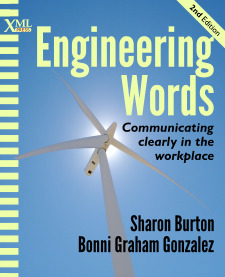
Engineering Words, 2nd edition
by Sharon Burton and Bonni Graham Gonzalez.
$45.95 (print), $29.95 (ebook).
Buy now at the XML Press eBook Store
Second Edition now Available
Over the course of a career, every engineer needs to communicate, in both written and oral form, with other engineers and non-engineers. Yet, too many engineers never develop this basic skill. Engineering Words draws on the authors’ extensive experience as technical communicators and teachers of a popular class in technical communication for engineers at the University of California, Riverside, to present a comprehensive introduction to communicating in the business world. This book covers everything from the basics of clear writing to résumés to cover letters to requirements documents to presentations and much more.
This second edition expands to cover writing tools (including AI tools), functioning in today’s workplace, ethics, and selling your ideas.
Engineering Words can be used as a textbook for classes that train engineers to be effective communicators. It can also serve as a self-study text that even experienced engineers will find useful for improving their communication skills.
Inside the Book
- Communication Guidelines: offers clear guidelines on the basics of writing for a business audience, and how to use modern tools, such as AI, to be more effective and efficient.
- Business Context: presents an overview of business finance and how to write for business peers and decision makers.
- The Workplace Ecosystem: shows you how to be effective in any environment, large or small, remote or on-premises.
- Résumés and Cover Letters: shows you how to create cover letters and résumés that work.
- Flow of a Project: describes the phases of a project and the documentation required in each phase.
- Effective Presentations: shows you how to create effective presentation slides and deliver a powerful presentation.
- Human Cognition: describes how to use our understanding of how people think to communicate more effectively.
- Constructing Explanations: describes how to explain complex information using visual design and user-focused structure.
- Personas and Scenarios: describes how to create and use personas and scenarios effectively.
- Writing Specifications: describes the different types of specifications (technical, functional, test, etc.) and, through examples, shows how to write each type.
- Testing Your Products: describes the different approaches that companies take to test products and describes both the testing process and how to properly document test cases and test suites.
- References and Index: an extensive list of references for further exploration and a comprehensive index.
Praise for the first edition
“The book fits well into the fields of communication design and technical communication” … “a valuable resource for professionals looking to improve their ability to create impactful and user-friendly communication artifacts.”
— Hua Wang, PhD, in Communication Design Quarterly (CDQ), Volume 12, Issue 4, page 71. Hua Wang is a Senior Lecturer in the College of Engineering at Cornell University, where she teaches engineering communication courses. Her work has appeared in the Journal of Technical Writing and Communication, Technical Communication Quarterly, and Rhetoric of Health and Medicine, several edited collections, and conference proceedings.
About Sharon Burton
Sharon Burton consults as a technical content strategist and teaches part time at the University of California, Riverside, in the Bourns College of Engineering. Leveraging her graduate cultural anthropology education, her career has been built around making content and content development easier for both businesses and content consumers. In that time, she’s also taught upwards of 8,000 people in corporate and university level courses.
In her spare time, she knits, sews, cooks, grows food, bakes bread, and rides her bike. Three or more nights a week, Sharon teaches baby engineers to communicate at the University of California, Riverside, as part of the engineering program.
She is the author of 8 Steps to Amazing Webinars.
About Bonni Graham Gonzalez
Bonni Graham Gonzalez teaches part time at the University of California, Riverside, in the Bourns College of Engineering. Bonni’s career has focused around storytelling, including designing and writing manuals that actually explain how to use products and creating award-winning marketing materials that both educate and sell.
When not marketing or thinking about marketing, Bonni crochets, beads, cooks, plays with her dog, and goes on road trips with her husband.
